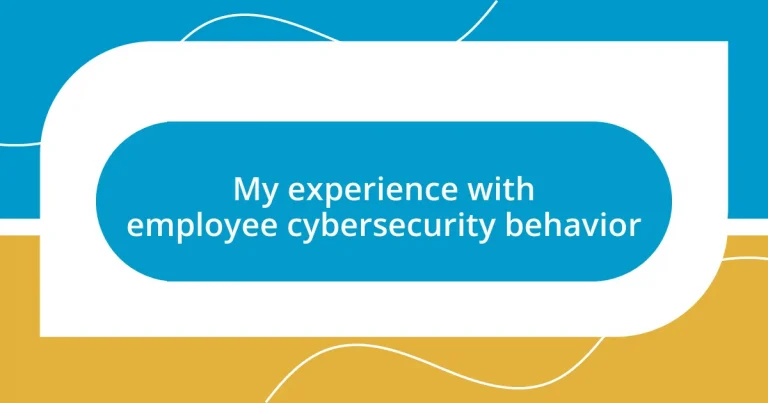Key takeaways:
- Employees often engage in risky cybersecurity behaviors out of habit, highlighting the need for ongoing, relatable training that fosters personal responsibility and openness.
- Common threats include phishing, outdated software, and insider threats, necessitating a proactive culture where employees are empowered to report and discuss vulnerabilities.
- Future cybersecurity practices will focus on integrating emotional intelligence in training, utilizing adaptive technologies, and promoting employee well-being to enhance overall security resilience.
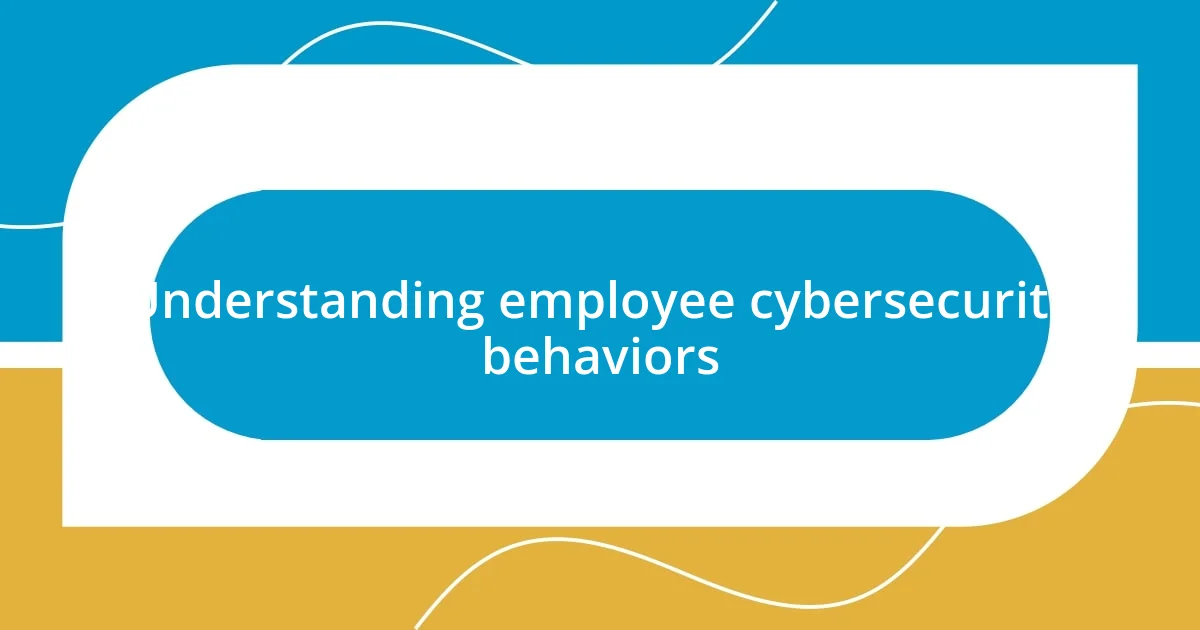
Understanding employee cybersecurity behaviors
Understanding employee cybersecurity behaviors is crucial in creating a robust security culture within an organization. Reflecting on my experience, I’ve noticed that employees often act out of habit when it comes to cybersecurity. This habitual behavior can lead to risky practices—like reusing passwords or ignoring software updates—which can be difficult to break.
I remember a particular incident where a colleague opened a suspicious email attachment, thinking it was harmless. This made me realize how easily a moment of distraction can compromise our security. It’s not just about knowledge; it’s about having the right mindset. How do we shift that mindset? It starts with ongoing training that resonates with personal experiences rather than just theory.
There’s an emotional component too; when employees feel they are genuinely part of a cybersecurity initiative, they take ownership. I’ve witnessed the difference it makes when team discussions about security concerns encourage vulnerability rather than shame. This approach fosters a safe space for asking questions, which is vital, as curiosity often curtails negligence. How can we encourage curiosity in our cybersecurity protocols? By connecting the dots between personal responsibility and the broader implications on team security.
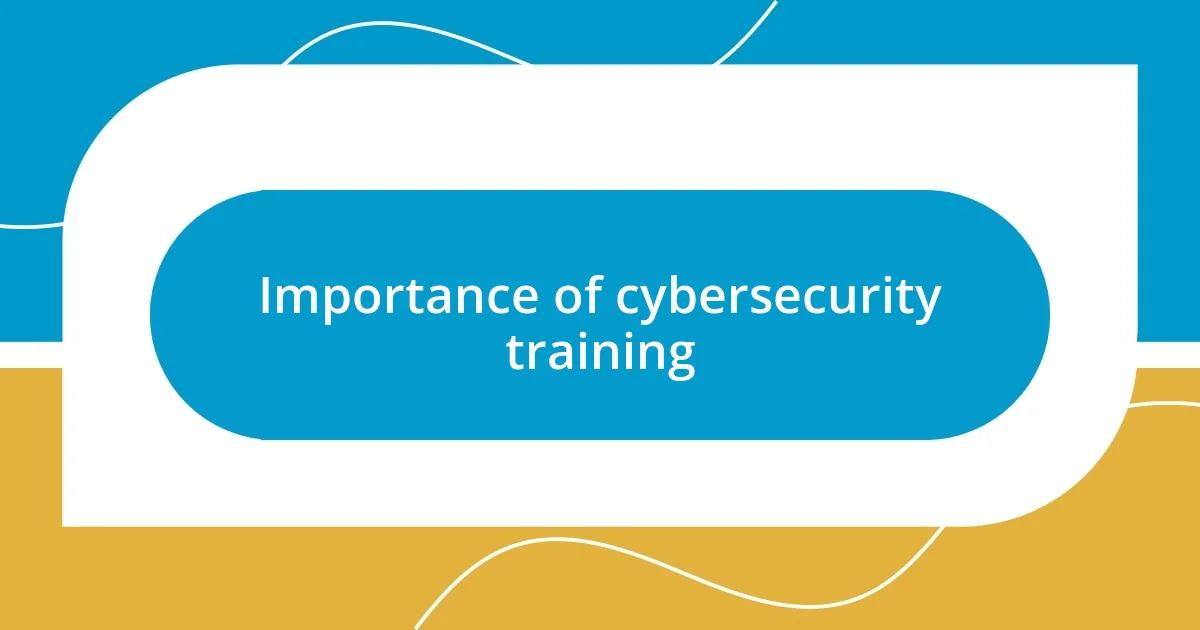
Importance of cybersecurity training
Effective cybersecurity training is paramount in nurturing a culture where security is everyone’s responsibility. I’ve seen firsthand how comprehensive training programs can transform employees from passive participants into active defenders of their workplace’s digital assets. For instance, after one training session, a team member shared how they once hit “ignore” on a software update but now actively looks for reminders and encourages others to do the same. It’s moments like these that make me appreciate the tangible shifts in mindset training can create.
Key reasons why cybersecurity training is important:
- Awareness of Threats: Training increases familiarity with various cyber threats, making employees more vigilant.
- Promotion of Best Practices: It helps instill habits, like using strong, unique passwords and recognizing phishing attempts.
- Fostering Responsibility: Employees who receive training often feel a greater sense of ownership over their actions related to security.
- Creating a Supportive Environment: Training sessions can lay the groundwork for open discussions about vulnerabilities, reducing the stigma around asking for help.
- Adaptability to New Threats: Cybersecurity is continually evolving; ongoing training ensures that employees can adapt to emerging security trends.
By making training relatable and engaging, I’ve seen teams become more proactive rather than reactive, which significantly enhances overall cybersecurity resilience.
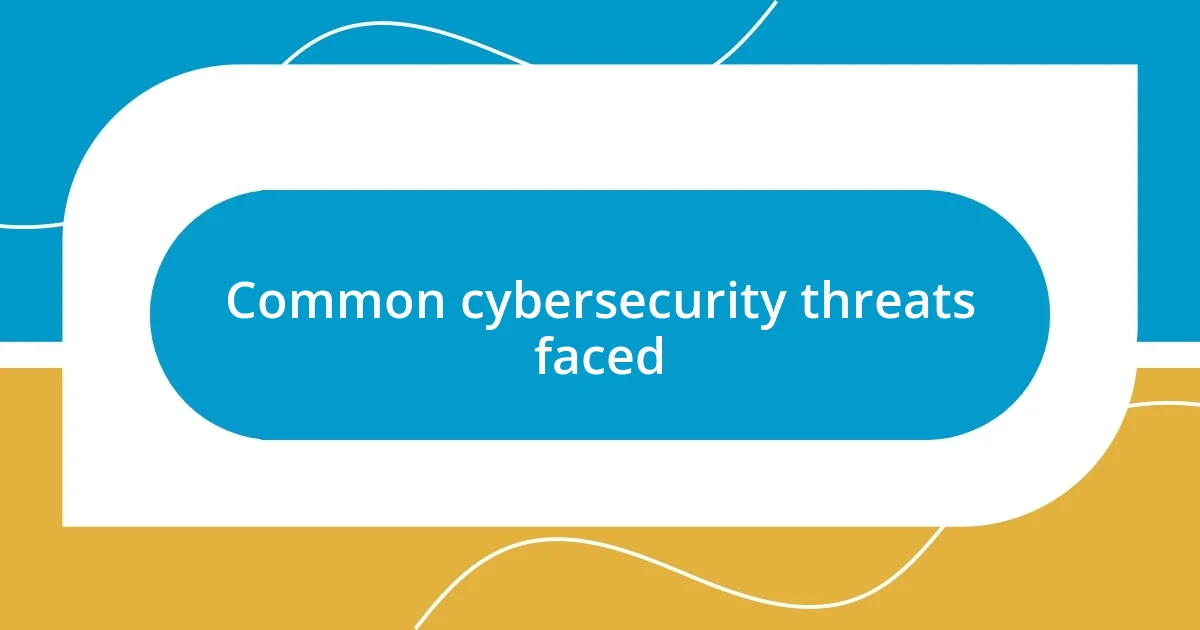
Common cybersecurity threats faced
Cybersecurity threats are more common than many realize, often manifesting in ways that are surprisingly simple yet effective. One of the biggest threats I’ve encountered is phishing. It’s fascinating how so many people still fall for these deceptive emails. I recall a time when a friend, a savvy professional, clicked on a link that appeared to be from a trusted source. The aftermath was a lesson that we often underestimate the power of scrutiny.
Another prevalent threat is the use of outdated software. Sometimes, employees may feel that updates are just another inconvenience, but in reality, they are critical for security. I’ve seen teams dismiss update notifications, thinking they can get around to them later. Unfortunately, this can leave systems vulnerable, exposing sensitive data. It always makes me rethink how we can incentivize these updates beyond just a reminder in the corner of a screen.
Lastly, insider threats are a real concern as well. Sometimes, it’s not an external hacker but rather an employee who unknowingly jeopardizes security by mishandling sensitive information. I remember a project where a colleague shared access to important files with an unsecured personal cloud service, thinking it was harmless. This experience emphasized the need for constant dialogue about data handling from day one.
| Threat | Description |
|---|---|
| Phishing | Fraudulent attempts to obtain sensitive information via deceptive emails or messages. |
| Outdated Software | Failure to update software can lead to vulnerabilities that hackers exploit. |
| Insider Threats | Security risks originating from within the organization, often from employees unknowingly mishandling data. |
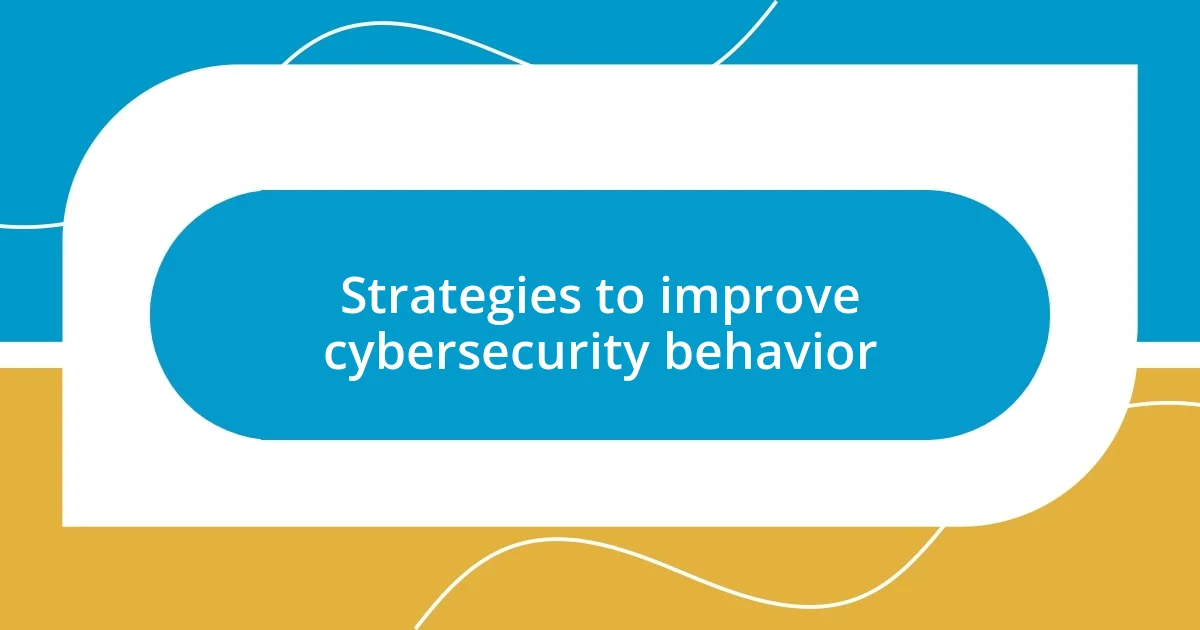
Strategies to improve cybersecurity behavior
One effective strategy I’ve found is implementing regular simulations of cyber threats, especially phishing attacks. When I participated in one such exercise, it was eye-opening to realize just how easily someone could fall for a seemingly legitimate email. By actively engaging employees in these simulations, we not only highlight potential risks but also cultivate a mindset of vigilance. Could you imagine feeling that rush of adrenaline when recognizing a phishing attempt? It builds confidence and enhances our collective defenses.
Another strategy worth considering is creating a buddy system for cybersecurity. I experienced this firsthand when I paired up with a colleague who was less experienced with tech issues. We made it a point to check each other’s practices, like password management and software updates. This not only made the process less daunting for both of us but also fostered a supportive environment where we felt empowered to ask questions without judgment. How simple yet effective it is to share the load of responsibility!
Lastly, encouraging open communication about cybersecurity, including reporting suspicious activity, goes a long way. In my previous role, we established a dedicated channel for employees to share concerns or unusual observations. This initiative sparked numerous conversations about best practices and created an atmosphere where questioning security processes became second nature. Have you ever noticed how discussing fears can diminish their power? It’s such a subtle yet impactful shift that cultivates a proactive rather than reactive mindset.
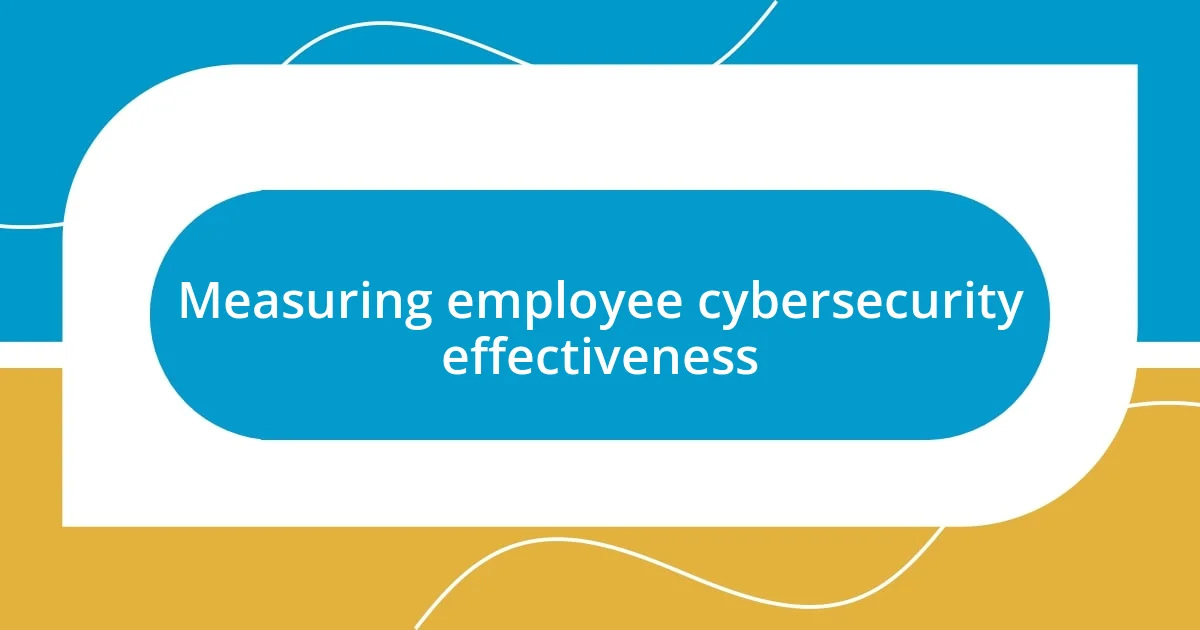
Measuring employee cybersecurity effectiveness
Measuring the effectiveness of employee cybersecurity behavior often feels like navigating a maze. During a security workshop I once attended, there was a moment when the facilitator shared a shocking statistic: nearly 70% of cybersecurity breaches stem from employee actions. That realization hit home for me. It made me reflect on how crucial it is not just to train employees but to continually evaluate their understanding and responses to cyber risks. How do we really know if they’re absorbing the information?
One method that has worked well in my experience is using assessments or quizzes after training sessions. I remember a time when a little quiz post-training revealed some surprising gaps in knowledge among my team. It wasn’t just about whether they could recite facts—it highlighted the misunderstandings that often go unaddressed. This process helped us tweak our training strategy, making it more tailored and relevant, ultimately reinforcing our cybersecurity foundation. Have you ever noticed how a simple quiz can turn vague knowledge into concrete understanding?
Beyond quizzes, monitoring behavior through real-time analytics can provide valuable insights into how employees are applying cybersecurity principles in their day-to-day tasks. For instance, I recall a project where we used software to analyze how often employees were reporting suspicious emails. The results were both encouraging and concerning—many were vigilant, but a concerning number did not engage. It prompted a discussion about the fine line between confidence and complacency. Are we really monitoring our effectiveness if we don’t take a closer look? By analyzing such behaviors, we can identify trends and potential areas for improvement, fostering a culture where cybersecurity is seen as a shared responsibility rather than a chore.
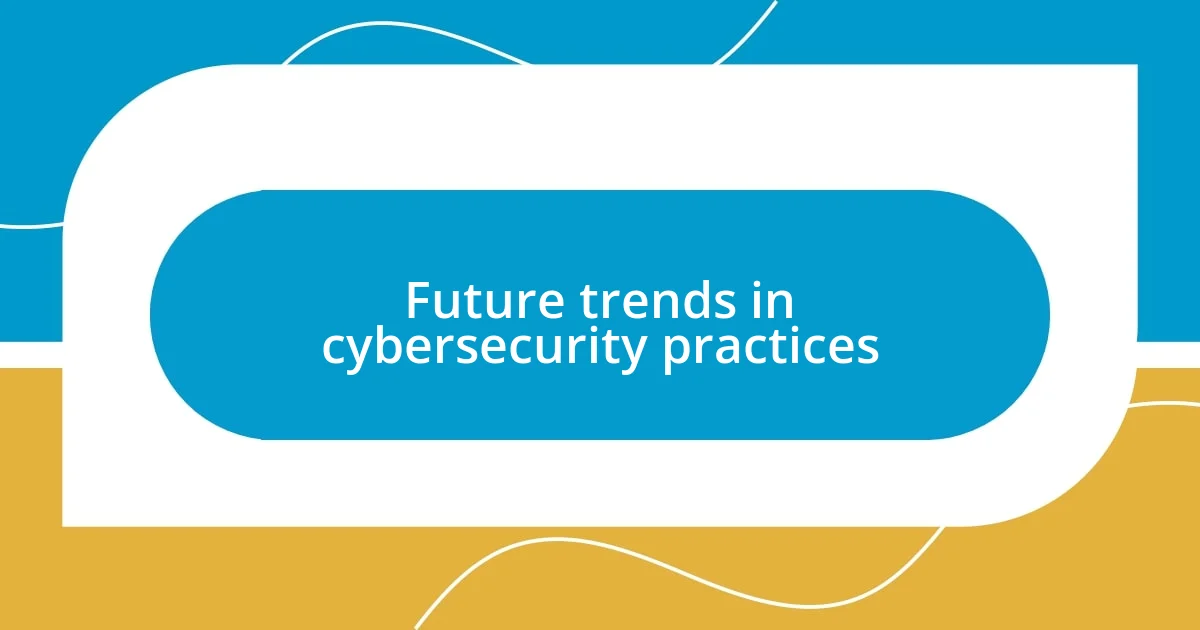
Future trends in cybersecurity practices
The future of cybersecurity practices is headed towards a more integrated and human-centered approach. I vividly remember a discussion during a tech seminar where an expert emphasized the growing need for emotional intelligence in security training. Imagine how powerful it would be if we taught employees not just the ‘how’ but the ‘why’ behind security measures. Educating them about the impact of their actions can instill a sense of ownership; now, that’s a game changer!
Another trend I foresee is the rise of adaptive security technologies. I once worked with a team implementing machine learning tools that could adjust in real-time to user behavior. It was fascinating to see how these systems learned and evolved, flagging unusual activities that a human might overlook. Do you ever wonder how life would be easier if technology could provide personalized security adjustments? It’s about transforming cybersecurity from a rigid set of rules into an intelligent system that aligns with how we naturally work.
Lastly, cybersecurity awareness is increasingly blending with overall employee well-being. I recall last year when my company launched wellness programs that incorporated mindfulness and stress management alongside cybersecurity training. The shift in mindset was palpable; when employees felt mentally supported, they were less likely to make hasty decisions, like clicking on a dubious link out of frustration. Isn’t it remarkable how intertwining these practices leads to a more secure and resilient workforce?












